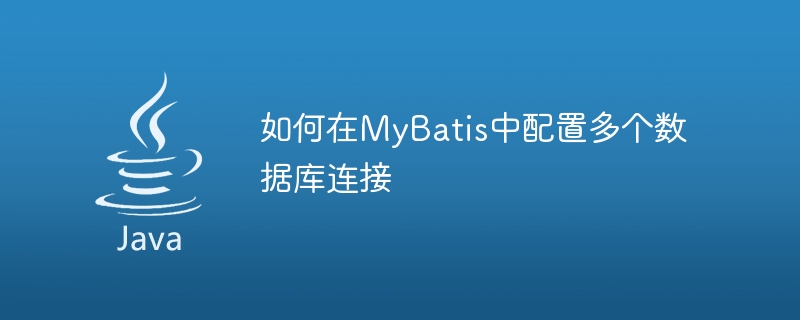
如何在MyBatis中設定多個資料庫連線
引言:
在現代應用程式開發中,常常需要連接多個資料庫來滿足不同業務需求。 MyBatis作為一種流行的持久層框架,可以很方便地與多個資料庫進行互動。本文將介紹如何在MyBatis中配置多個資料庫連接,並提供具體的程式碼範例。
步驟一:引入相關依賴
在專案的pom.xml檔案中,加入MyBatis和資料庫驅動的依賴。例如,如果使用Oracle資料庫,則可以新增以下依賴:
<dependency>
<groupId>org.mybatis</groupId>
<artifactId>mybatis</artifactId>
<version>3.5.5</version>
</dependency>
<dependency>
<groupId>com.oracle.database.jdbc</groupId>
<artifactId>ojdbc8</artifactId>
<version>19.8.0.0</version>
</dependency>步驟二:設定資料來源
在MyBatis中,我們可以使用多種方式來設定資料來源,例如使用JNDI、Spring、或者直接在MyBatis設定檔中設定資料來源。
以下是一種常見的在MyBatis配置中配置多個資料庫連接的方式:
<!-- 数据源一 -->
<dataSource type="com.zaxxer.hikari.HikariDataSource">
<property name="driverClassName" value="oracle.jdbc.driver.OracleDriver"/>
<property name="jdbcUrl" value="jdbc:oracle:thin:@localhost:1521:ORCL"/>
<property name="username" value="user1"/>
<property name="password" value="password1"/>
</dataSource>
<!-- 数据源二 -->
<dataSource type="com.zaxxer.hikari.HikariDataSource">
<property name="driverClassName" value="com.mysql.cj.jdbc.Driver"/>
<property name="jdbcUrl" value="jdbc:mysql://localhost:3306/db2?useSSL=false&allowPublicKeyRetrieval=true&serverTimezone=UTC"/>
<property name="username" value="user2"/>
<property name="password" value="password2"/>
</dataSource>以上例子中,我們配置了兩個資料來源,一個連接Oracle資料庫,一個連接MySQL資料庫。
步驟三:設定MyBatis會話工廠
在MyBatis設定檔中,我們需要設定會話工廠(SqlSessionFactory)來管理資料庫連線和會話。可以透過使用多個資料來源和多個資料庫連接工廠來實現多個資料庫連線。
以下是一個簡單的範例設定:
<!-- 数据源一的数据库连接工厂 -->
<bean id="sqlSessionFactory1" class="org.mybatis.spring.SqlSessionFactoryBean">
<property name="dataSource" ref="dataSource1"/>
</bean>
<!-- 数据源二的数据库连接工厂 -->
<bean id="sqlSessionFactory2" class="org.mybatis.spring.SqlSessionFactoryBean">
<property name="dataSource" ref="dataSource2"/>
</bean>
<!-- MyBatis会话工厂 -->
<bean id="sqlSessionFactory" class="org.mybatis.spring.SqlSessionFactoryBean">
<property name="dataSource" ref="dataSource"/>
<property name="mapperLocations" value="classpath*:mapper/*.xml"/>
<property name="configLocation" value="classpath:mybatis-config.xml"/>
</bean>在上述範例中,我們分別配置了兩個資料庫連接工廠(sqlSessionFactory1和sqlSessionFactory2),並在最終的MyBatis會話工廠(sqlSessionFactory )中進行了引用。
步驟四:在Mapper介面中使用多個資料庫連線
在使用多個資料庫連線時,我們需要在Mapper介面中指定要使用哪個資料庫連線。
以下是一個範例Mapper介面的定義:
public interface UserMapper {
// 数据源一的查询
@Mapper
@DataSource("dataSource1")
List<User> getUsersFromDataSource1();
// 数据源二的查询
@Mapper
@DataSource("dataSource2")
List<User> getUsersFromDataSource2();
}在上述範例中,我們使用@DataSource註解來指定特定的資料來源,例如@DataSource("dataSource1")表示使用數據源一進行查詢。
結論:
透過上述步驟,我們可以在MyBatis中輕鬆設定多個資料庫連線。在實際應用中,可以根據具體需求來配置多個資料來源和資料庫連接工廠,從而滿足不同業務需求。
在實際開發中,多個資料庫連線的配置可能會更加複雜,例如涉及到交易管理、動態資料來源切換等。可根據具體情況進一步配置和調整。
以上是配置MyBatis連接多個資料庫的方法的詳細內容。更多資訊請關注PHP中文網其他相關文章!




